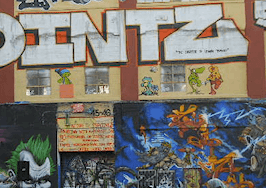In an unprecedented decision, jurors in a Brooklyn federal court Tuesday ruled largely in favor of more than 20 artists who accused developer Jerry Wolkoff of violating the national Visual Artists Rights Act when he painted over their graffiti on his Long Island City, Queens, building in 2013.
Jurors determined that some of the 49 pieces of aerosol art whitewashed at the iconic 5 Pointz building qualify under a “recognized stature” clause of the rarely tested Visual Artists Rights Act, which grants federal protection to distinguished works of art. The verdict could have wide-ranging implications for real estate developers nationwide, who may now be exposed to astronomical fines for the mishandling of art.
The jury verdict, heralded following two days of deliberation, is advisory, and Judge Frederic Block is expected to make a final ruling on damages, according to the New York Daily News.
“It’s going to be a difficult thing, I think, to figure out how to value this kind of work, particularly when it’s not about infringement, but a loss of the work as a whole, completely,” said Kate Lucas, an attorney at Grossman LLP, a law firm with prior experience in the field of art law.
The trial, which began in October, centered around the destruction of mural-sized art covering the iconic 5 Pointz factory building at 45-46 Davis St. The artists accused Wolkoff of violating the Visual Artists Rights Act, which protects art of “recognized stature,” when he whitewashed the building in 2013 and demolished it a year later to make way for residential towers.
A subsection of the Copyright Act, the 1990 Visual Artists Rights provision protects against “intentional distortion, mutilation or other modification,” but had rarely, if ever, been tested in court. Experts believe artists in the past may have either settled out of court or neglected to take legal action due to the costly price of litigation, especially for a young or emerging artist.
At 5 Pointz, Wolkoff was the rare developer in the real estate industry who willingly allowed street artists to cover the 200,000-square-foot building with colorful graffiti and vibrant murals. As early as 1993, the developer had welcomed the artists, but no contractual agreements are known to have been signed, and the artists themselves often painted over their own work.
Judge Block is expected to rule on damages later this month.
Email Jotham Sederstrom.













